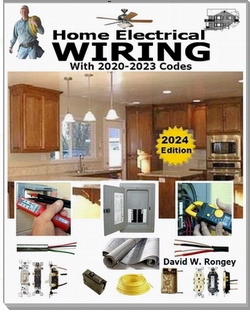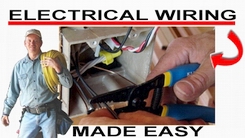» Need Electrical Help? Ask the Electrician
Whole House Fan Switch

|
By Dave Rongey
Summary: Electrical Switches Question: I have a whole house attic fan. This is not to be confused with fan which solely ventilates the attic (I have one of those too, but it is off topic. © By: Dave Rongey |
How to Wire a Whole House Fan Switch
Wiring a Whole House Fan Switch.
I have a whole house attic fan. This is not to be confused with fan which solely ventilates the attic I have one of those too, but it is off topic. The whole house attic fan I refer to pushes air out of the attic through a large fan in the attic, and in so doing, sucks air through louvers than open when the fan is on in the ceiling between my home's top ,i.e. 2nd, livable floor and the attic, and blows this air outside, so the air pressure differential, less pressure in the house than outside, is resolved by air flowing into the house from outside, through open windows, allowing cool fresh air to come into the house.
The attic fan has 2 speeds: low and high. The louvers IN FRONT OF THE FAN, located in the attic, open by the wind generated by the fan (i.e. these louvers are NOT energized), but the aforementioned louvers IN THE 2nd floor CEILING open via an electrified switch, that when energized with electric, pulls the louvers open. Like any good \ dead man's switch,\ once the attic fan is turned off at a switch I will discuss in a moment, energy to the ceiling-louvers-opening dead man's switch is cut off, and wound springs in the dead man switch close the louvers in the 2nd floor ceiling.
This whole house fan is powered by a Leviton switch that has 3 positions .Up, for running the fan on one particular speed (we'll say high speed)and energizing/opening and keeping open, the ceiling louvers. The switch's middle position is where the fan is off and the ceiling louvers are closed. In the switch's down position, the fan operates at a lower speed, and the ceiling louvers are also energized and opened. This switch looks like it is from the 1960's and although it still works fine, I'd like to replace it with one that's more architecturally pleasing.
After doing my research, I thought the Leviton 5686-2 switch, http://www.leviton.com/OA_HTML/ibeCCtpItmDspRte.jsp?sitex=10026:22372:USanditem=8149 which is a 3 position 15 amp switch (like the switch I wish to replace), double pole and double throw, might do the trick, but I am having problems getting it to work.
The whole house fan is on a 20 amp circuit -as per my check of the circuit box in the basement. Let me describe the existing wiring. If I were to take the existing old switch out of the wall and look at it in the same position as it sits in the wall, I would see 6 screw terminals (3 rows and 2 columns of screws)
It would appear the wire carrying electric (i.e. hot) first connects to the middle row's left screw, and then to the middle row's right screw. It would appear that the wire which controls energizing the ceiling louvers is connected to the bottom row of screw's left side, and then continues to connect to the top row of screw's left side. Two wires, which I believe connect to the attic fan motor, and which I believe control whether the fan opening motor.)
Having examined the existing switch, I cannot glean anything about its model number, etc. by examining it, except that it was made by Leviton. It's one of those switch you grab with your thumb, pointer, and middle finger, that you might find on audio visual equipment from the 1960s. My guess is that the switch does not have rheostat capabilities. It's internal mechanics is inside this tiny box, but I might be wrong. Maybe I should go up into the attic at get some information off of the attic fan motor.
Thanks, Russell K.
Hi Russell,
Can you get any specifications from the existing switch?
Here are some initial things to address:
Some motors are controlled by a switch that acts like a rheostat, that is the speed is controlled from the electronics inside the switch, while other switches contain contacts only and the speed control is accomplished from the internal motor windings alone.
Identifying the original switch will really help.
The Safest Way to Test Electrical Devices and Identify Electric Wires!The Non-Contact Electrical TesterThis is a testing tool that I have had in my personal electrical tool pouch for years, and is the first test tool I grab to help identify electrical wiring. It is a Non-contact tester that I use to easily Detect Voltage in Cables, Cords, Circuit Breakers, Lighting Fixtures, Switches, Outlets and Wires. Simply insert the end of the tester into an outlet, lamp socket, or hold the end of the tester against the wire you wish to test. Very handy and easy to use.
The Quickest Way to Check for Faulty Electrical Wiring!The Plug-In Outlet TesterThis is the first tool I grab to troubleshoot a problem with outlet circuit wiring. This popular tester is also used by most inspectors to test for power and check the polarity of circuit wiring. It detects probable improper wiring conditions in standard 110-125 VAC outlets Provides 6 probable wiring conditions that are quick and easy to read for ultimate efficiency Lights indicate if wiring is correct and indicator light chart is included Tests standard 3-wire outlets UL Listed Light indicates if wiring is incorrect Very handy and easy to use.
Strip Off Wire Insulation without Nicking and Damaging the Electric Wire!The Wire Stripper and Wire CutterMy absolute favorite wire stripping tool that I have had in my personal electrical tool pouch for years, and this is the tool I use to safely strip electrical wires. This handy tool has multiple uses: The wire gauges are shown on the side of the tool so you know which slot to use for stripping insulation. The end of the tool can be used to grip and bend wire which is handy for attaching wire onto the screw terminals of switches and outlets.. The wire stripper will work on both solid and stranded wire. This tool is Very Handy and Easy to Use. |
||
Switches Parts and AccessoriesLight Switch Single Pole 3 Way Light Switch 4 Way Light Switch Switch and Outlet Combo Dimmer Switch |














